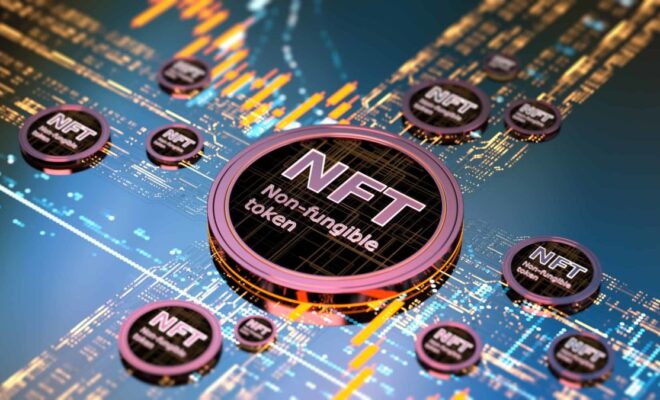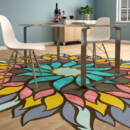Exploring the Future of Graphic and Creative Design with Non-Fungible Tokens (NFTs)

Non-Fungible Tokens (NFTs) have been making headlines in the digital world lately, with record-breaking sales of digital art and collectibles.
This technology has opened up new possibilities for artists and designers, allowing them to sell their work as verifiable and valuable assets. With NFTs, creators can maintain ownership and control over their work, even as it is bought and sold on the open market.
As the use of NFTs continues to grow, many are exploring the potential for this technology in the world of graphic and creative design. From digital art and illustrations to website design and branding, NFTs could revolutionise the way that designers create and sell their work.
What are NFTs?
Digital assets known as Non-Fungible Tokens (NFTs) are exclusive and non-transferable. They are based on blockchain technology, a decentralised ledger with immutable transaction records. NFTs are used to represent ownership of digital assets such as art, music, videos, and other creative works.
NFTs have gained popularity in recent years due to the ability to verify ownership and authenticity of digital assets. Each NFT has a unique identifier that makes it impossible to replicate or duplicate. This means that the original creator of the digital asset can prove ownership and control over it, even if it is shared or copied online.
The value of NFTs is determined by the market demand for the digital asset they represent. The ability to monetise digital assets has opened up new opportunities for an NFT graphic and creative designer to earn a living from their work.
NFTs and Graphic Design
Non-fungible tokens (NFTs) can be used to represent a variety of digital assets, including artwork, music, and even tweets. NFTs are unique and cannot be replicated or replaced, which makes them valuable to collectors and investors.
Graphic designers are starting to explore the potential of NFTs in their work. NFTs can be used to create digital art that is unique and valuable. This opens up new opportunities for graphic designers to create and sell their work directly to collectors and investors.
Using NFTs in graphic design has a number of advantages, one of which is the capacity to validate authenticity and ownership. With traditional digital art, it can be difficult to prove that you own the original work. However, with NFTs, ownership is recorded on the blockchain, which makes it easy to verify.
Another benefit of using NFTs in graphic design is the potential for increased revenue. NFTs can be sold at auction, and the value of the artwork can increase over time. This means that graphic designers have the potential to earn more money from their work than they would with traditional digital art.
Overall, NFTs are an exciting new development in the world of graphic design. They offer unique opportunities for designers to create and sell their work, while also providing a way to prove ownership and authenticity.
The Future of NFTs in Creative Design
NFTs have already made a significant impact on the world of art, and it’s only a matter of time before they revolutionise the creative design industry as well. Here are a few ways NFTs could shape the future of creative design:
- Ownership and Authenticity: NFTs offer a safe and transparent means to demonstrate the ownership and validity of digital assets. This implies that designers can market their original works as one-of-a-kind NFTs, guaranteeing that the purchaser will actually own the original and not simply a replica.
- Royalties: NFTs can be programmed to automatically pay royalties to the original creator every time the asset is sold or traded. This could provide a new source of income for designers, who may currently struggle to earn a living from their work.
- Collaboration and Community: NFTs could facilitate collaboration between designers and their fans or followers. By creating and selling NFTs, designers could involve their community in the creative process and build a loyal fanbase.
- Innovation and Experimentation: NFTs could encourage designers to experiment with new forms of digital art and explore uncharted territories. The ability to sell and trade unique digital assets could incentivize designers to push the boundaries of what’s possible in creative design.
Overall, the future of NFTs in creative design is exciting and full of potential. As the technology continues to evolve and become more accessible, we can expect to see more and more designers embracing NFTs as a way to monetise their work and connect with their audience.
Benefits and Challenges of NFTs in Graphic Design
Non-Fungible Tokens (NFTs) have the potential to revolutionise the way graphic designers create and sell their work. Below are some of the benefits and challenges of using NFTs in graphic design:
Benefits
- Authenticity and ownership: NFTs provide a way for graphic designers to prove the authenticity and ownership of their work. This creates a unique value proposition for buyers who want to own a piece of original artwork.
- Revenue streams: NFTs can create new revenue streams for graphic designers. Instead of selling their work to a single buyer, designers can sell limited edition NFTs to multiple buyers.
- Transparency: NFTs are stored on a public blockchain, which provides transparency and traceability for buyers and sellers.
- Increased exposure: NFTs can increase exposure for an NFT graphic and creative designer by allowing their work to be easily shared and discovered on digital marketplaces.
Challenges
- Technical knowledge: NFTs are a new technology, and graphic designers may need to learn new technical skills to create and sell them.
- Environmental impact: The creation and transaction of NFTs require a significant amount of energy, which can have a negative impact on the environment.
- Market volatility: The value of NFTs can be highly volatile, which can create uncertainty for buyers and sellers.
- Legal and copyright issues: The legal and copyright implications of NFTs are still unclear, which can create legal risks for buyers and sellers.
Conclusion
Non-fungible tokens offer exciting opportunities for anyone working in graphic design and creative industries alike.
Creating unique digital assets and selling them through online marketplaces, designers can earn higher profits than ever before while simultaneously promoting their brands with innovative methods such as creating logo NFTs.
As this technology continues to evolve, it’s likely we’ll see more ways in which NFTs will revolutionise how we think about buying and selling artwork online!


